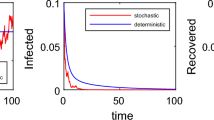Abstract
We study the conditions for the phase transitions of information diffusion in complex networks. Using the random clustered network model, a generalisation of the Chung-Lu random network model incorporating clustering, we examine the effect of clustering under the Susceptible-Infected-Recovered (SIR) epidemic diffusion model with heterogeneous contact rates. For this purpose, we exploit the branching process to analyse information diffusion in random unclustered networks with arbitrary contact rates, and provide novel iterative algorithms for estimating the conditions and sizes of global cascades, respectively. Showing that a random clustered network can be mapped into a factor graph, which is a locally tree-like structure, we successfully extend our analysis to random clustered networks with heterogeneous contact rates. We then identify the conditions for phase transitions of information diffusion using our method. Interestingly, for various contact rates, we prove that random clustered networks with higher clustering coefficients have strictly lower phase transition points for any given degree sequence. Finally, we confirm our analytical results with numerical simulations of both synthetically-generated and real-world networks.
Similar content being viewed by others
References
P.S. Dodds, D.J. Watts, Phys. Rev. Lett. 92, 218701 (2004)
S.N. Dorogovtsev, A.V. Goltsev, J.F.F. Mendes, Rev. Mod. Phys. 80, 1275 (2008)
J. Kleinberg, Commun. ACM 51, 66 (2008)
D. Easley, J. Kleinberg, Netwoks, Crowds, and Markets: Reasoning About a Highly Connected World (Cambridge University Press, 2010)
D. Gruhl, R. Guha, D. Liben-Nowell, A. Tomkins, Information Diffusion Through Blogspace, in Proc. of the 13th WWW, 2004, pp. 491–501
D. Liben-Nowell, J. Kleinberg, Proc. Natl. Acad. Sci. USA 105, 4633 (2008)
J.J. Cheng, Y. Liu, B. Shen, W.G. Yuan, Eur. Phys. J. B 86, 29 (2013)
R. Pastor-Satorras, A. Vespignani, Phys. Rev. Lett. 86, 3200 (2001)
R.M. Anderson, R.M. May, Infectious Diseases of Humans (Oxford University Press, 1991)
W.O. Kermack, A.G. McKendrick, Proc. R. Soc. Lond. A 115, 700 (1927)
J.C. Miller, A.C. Slim, E.M. Volz, J. R. Soc. Interface 9, 890 (2011)
E. Kenah, J.M. Robins, J. Theor. Biol. 249, 706 (2007)
E. Kenah, J.M. Robins, Phys. Rev. E 76, 036113 (2007)
J.C. Miller, Phys. Rev. E 76, 010101(R) (2007)
M.E.J. Newman, Phys. Rev. E 66, 016128 (2002)
P. Rattana, J. Miller, I. Kiss, Math. Modell. Nat. Phenom. 9, 58 (2014)
M.E.J. Newman, SIAM Rev. 45, 167 (2003)
E. Volz, Eur. Phys. J. B 63, 381 (2008)
P. Erdős, A. Rényi, Publ. Math. 6, 290 (1959)
R.M. D’Souza, Nat. Phys. 5, 627 (2009)
L.A. Meyers, B. Pourbohloul, M.E.J. Newman, D.M. Skowronski, R.C. Brunham, J. Theor. Biol. 232, 71 (2005)
A.L. Barabasi, Nature 435, 207 (2005)
J.L. Iribarren, E. Moro, Phys. Rev. Lett. 103, 038702 (2009)
M.E.J. Newman, Phys. Rev. Lett. 103, 058701 (2009)
J.C. Miller, Phys. Rev. E 80, 020901(R) (2009)
F. Chung, L. Lu, Ann. Combin. 6, 125 (2002)
F. Chung, L. Lu, SIAM J. Discrete Math. 20, 395 (2006)
B. Barry, I.S. Fulmer, Acad. Manag. Rev. 29, 272 (2004)
L. Weng, A. Flammini, A. Vespignani, F. Menczer, Sci. Rep. 2, 335 (2012)
R. Dunbar, How Many “Friends” Can You Really Have?, in IEEE Spectrum, 2011, Vol. 48, pp. 81–83
L.A. Adamic, R.M. Lukose, A.R. Puniyani, B.A. Huberman, Phys. Rev. E 64, 046135 (2001)
M.W. Hirsch, S. Smale, R.L. Devaney, in Differential Equations, Dynamical Systems, and an Introduction to Chaos (Academic press, 2004), Vol. 60
B. Bollobás, Random Graphs (Oxford University Press, 2001)
M. Molloy, B. Reed, Random Struct. Alg. 6, 161 (1995)
M. Molloy, B. Reed, Combinatorics, Probab. Comput. 7, 295 (1998)
M.E.J. Newman, S.H. Strogatz, D.J. Watts, Phys. Rev. E 64, 026118 (2001)
E. Kenah, J.C. Miller, Interdisciplinary Perspectives on Infectious Diseases 2011, 543520 (2011)
D. Wang, Z. Wen, H. Tong, C.Y. Lin, C. Song, A.L. Barabasi, Information Spreading in Context, in Proc. of the 20th WWW, 2011, pp. 735–744
D. Kempe, J. Kleinberg, E. Tardos, Maximizing the Spread of Influence through a Social Network, in Proc. of the 9th ACM SIGKDD, 2003, pp. 137–146
D. Chakrabarti, Y. Wang, C. Wang, J. Leskovec, C. Faloutsos, ACM Trans. Inform. Syst. Security 10, 1 (2008)
A. Ganesh, L. Massoulie, D. Towsley, The effect of network topology on the spread of epidemics, in Proc. of 24th IEEE INFOCOM, 2005, pp. 1455–1466
B.A. Prakash, D. Chakrabarti, M. Faloutsos, N. Valler, C. Faloutsos, Threshold Conditions for Arbitrary Cascade Models on Arbitrary Networks, in Proc. of 11th IEEE ICDM, 2011, pp. 537–546
B. Karrer, M. Newman, L. Zdeborová, Phys. Rev. Lett. 113, 208702 (2014)
B. Viswanath, A. Mislove, M. Cha, K.P. Gummadi, On the Evolution of User Interaction in Facebook, in Proc. of the 2nd ACM WOSN, 2009, pp. 37–42
Y.Y. Ahn, S. Han, H. Kwak, S. Moon, H. Jeong, Analysis of topological characteristics of huge online social networking services, in Proc. of the 16th WWW, 2007, pp. 835–844
A.L. Barabasi, Philos. Trans. Roy. Soc. London A 371, 20120375 (2013)
J.P. Gleeson, S. Melnik, A. Hackett, Phys. Rev. E 81, 066114 (2010)
E. Coupechoux, M. Lelarge, Adv. Appl. Probab. 46, 985 (2014)
Author information
Authors and Affiliations
Corresponding author
Rights and permissions
About this article
Cite this article
Lim, S., Shin, J., Kwak, N. et al. Phase transitions for information diffusion in random clustered networks. Eur. Phys. J. B 89, 188 (2016). https://doi.org/10.1140/epjb/e2016-60612-y
Received:
Revised:
Published:
DOI: https://doi.org/10.1140/epjb/e2016-60612-y




